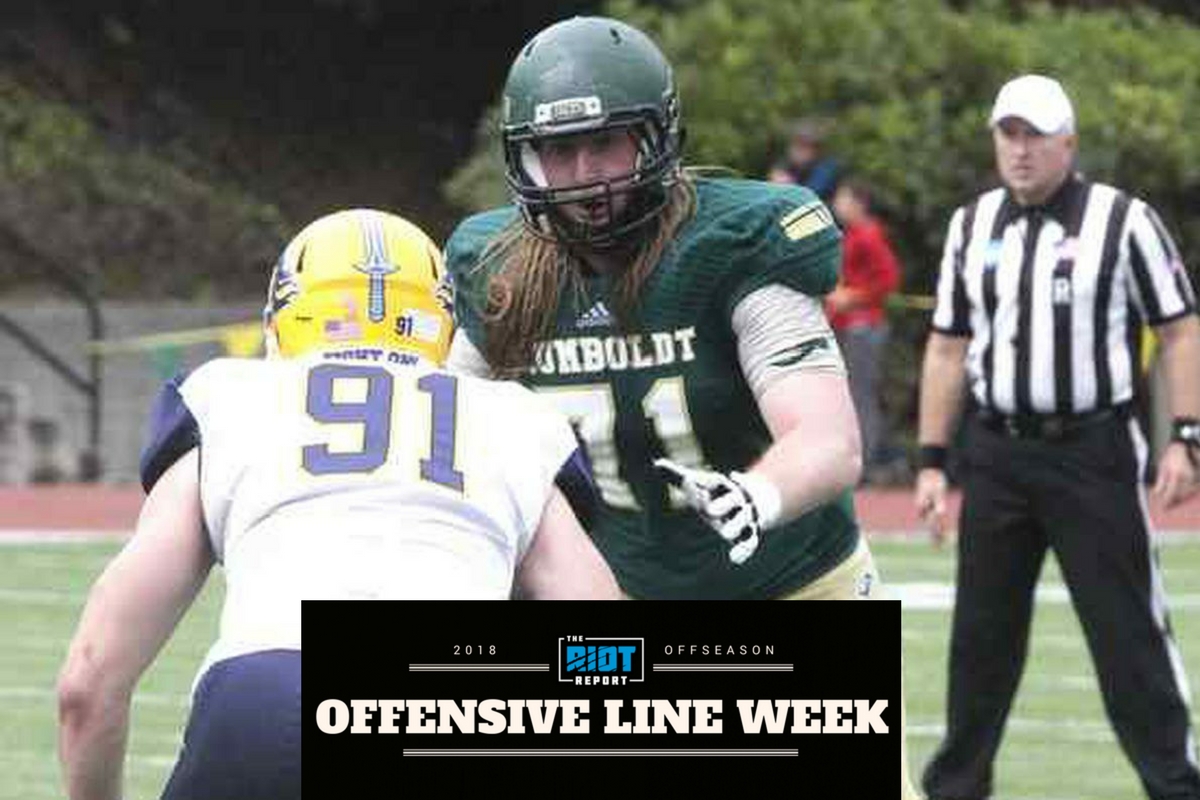Each week this offseason, we’ll be focusing on one position and how the Panthers may choose to address their needs; whether they’re in the market for an upgrade at starter or just a reliable backup, every player on the 53-man roster is going to be important in 2018.
This is Offensive Line Week.
Should Andrew Norwell return to the Panthers for 2018, it would be surprising to see any roster additions winning a starting spot on the offensive line. There is also the possibility that Norwell leaves and last year’s second-round pick Taylor Moton moves into his guard spot; in that case, adding depth is always valuable. If that depth also has the ability to develop into either a starter or a tradeable asset in the future, then all the better; when it comes to developmental offensive line prospects in the 2018 draft, Alex Cappa has a lot to like.
Athleticism
When looking at small school draft prospects, and especially for those viewed as developmental prospects, athleticism is going to be of significant interest. These prospects will often not be the most technically polished, but without the athletic potential, teams will have little interest in putting in the time to try and develop that athleticism. While Cappa might not be the flashiest athlete, his combination of power, agility and body control has the potential to allow him to be a quality starter in the NFL, should he develop the technique to match it.
Cappa played left tackle in college, and while he could well make the move to guard in the NFL, he does show an ability to follow rushers around the edge on tape, such as on the following plays. For reference, Cappa is #71.
While this might not be the elite speed-stifling lateral agility of the very best tackle prospects, he was rarely, if ever, beaten around the edge in pass protection at a lower level of competition; what is also very encouraging is how he was able to do this while maintaining body control. Often, prospects who lack that top-level slide see a breakdown in body control in these situations as they sacrifice balance for sideways speed. In doing so, they put themselves at risk of power and inside moves which take advantage of tackles who put too much weight on their back foot. On the following play, the end looks to bull rush Cappa once he gets into his backpedal, but Cappa shows the restraint to play within his limits and is able to easily stifle the power move:
While athleticism itself is extremely useful, an understanding of where your athletic limits lie is also valuable; when offensive linemen attempt to play beyond their athleticism they make themselves easy pickings.
As well as this lateral agility and body control, Cappa also has a decent amount of power as a blocker. While this would probably be less impressive as a guard than as a tackle, a conversion that is certainly a possibility, he did show an ability to move his man in the run game on tape, such as on the next two plays:
As somewhat of an added bonus, Cappa also shows an ability to move well in space, such as on the following play where he shows both surprising speed and a good level of body control to get to the second level and seal off the running lane:
While Cappa doesn’t stand out significantly in any one area, his value comes in the combination of assets rather than the mastery of any given one. There are more powerful and more agile tackles in this draft class, but very few are better than Cappa in both regards.
Technical Flashes
As should be expected of somebody from a smaller school, Cappa’s technique does need some work. However, what should encourage teams is the ability he has shown in various core areas. Play height is a common concern with athletic small-school prospects; while it can be worked on, players that show consistently poor pad level are often unable to develop a consistent pad level when they make the move to the NFL. While there are times, such as on the next play, when Cappa fails to keep his waist bent, his play height was generally decent:
This next play shows a much better pad level, and while he does reach somewhat at the end, the pad level throughout is encouraging.
The other area of technical competence that Cappa demonstrates is in his hand usage; in pass protection, this starts with the control of the arms and hands before contact is made. Many tackles have a tendency to swing their arms outside their frames in their slide in order to aid their balance, but this has a tendency to expose the frame of the tackle making them vulnerable to more refined pass rushing moves. On the play below, Cappa clearly keeps his arms inside his frame and is easily able to counter the moves of the defender:
This then allows him to control the defender throughout the play, thereby negating much of the pass rushing threat, as can be seen on these plays:
In the run game, this also allows him to push through the defender for maximum effectiveness, and while he does have a tendency to lean somewhat, this is something that NFL coaching should be able to correct. This punch can be seen on plays such as this:
Cappa is not a perfectly pro-ready prospect, but with NFL coaching and work in the weight room, he shows the core ingredients needed to develop into a quality guard or tackle at the NFL level. If he is still available on the third day of the draft, he could provide the Panthers with a prospect who provides both immediate depth and long-term upside.



